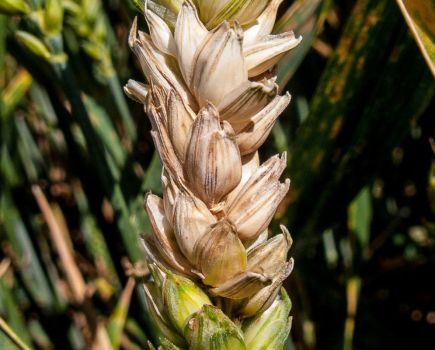Could improving nitrogen assimilation and carbon fixation be the key to helping autumn crops to bounce back from adversity? CPM investigates the potential of 2-oxoglutaramate technology.
“It’s important to consider the bigger picture – it’s a cost effective addition that doesn’t break the bank.”
By Janine Adamson
With much focus on spring cropping options and plan Bs, and perhaps in some cases plan Cs, for those with autumn cereal crops still standing, what can be done to give them a recovery boost?
Given the likelihood there will have been waterlogging at some point, Unium’s Andrew Cromie says crop stress will be high whereas rooting capacity will be low. “The importance of rooting is widely recognised, not just for its role in water and nutrient uptake, but for tillering too.
“Unfortunately, poor rooting means reduced tillering and if you look at the relationship between tillering and yield, research has shown the two are intrinsically linked.”
He says as a result, the priority should be to encourage crops to push out roots and scavenge for vital nutrients which will have been washed further away from the root zone during the inclement weather. “Applying calcium phosphite as soon as you can travel will help to encourage those roots down into the soil profile,” recommends Andrew.
“Equally, crops will come out of dormancy and be hungry so providing adequate nutrition will be vital for survival and performance. However, when it comes to applied nutrition, and in particular large amounts of nitrogen, there can be a bottleneck within the plant’s metabolism and pathways.
“This means the mission to promptly offset the stress of the autumn by topping up nutrition and boosting rooting, can be set back.”
However, thanks to science, there’s the potential to alleviate this bottleneck by improving the process and enhancing nutrient use efficiency through application of a natural plant metabolite – 2-oxoglutaramate (2-oxo).
2-oxo stimulates the plant to increase both nitrogen and CO2 uptake, which results in improved biomass and yield, and creates a similar effect to that of elevated atmospheric CO2 levels. It achieves this through exploiting the glutamine synthetase pathway. Simply put, it increases both carbon fixation and nitrogen assimilation.
Although it’s widely understood that the growth and productivity of plants depends on a balanced distribution of carbon and nitrogen, recent findings reveal they also form a complex integrated network and are often dependent on each other.
To take this further, during research into 2-oxo, Dr Pat Unkefer discovered that this relationship could be improved through the addition of L-GPA (pidolic acid). Although it’s been proven that 2-oxo is superior to L-PGA, thanks to a synergistic effect, the combination outperforms either separately.
Together, they’re presented as Unium’s Twoxo – an NUE signalling compound for use when the largest application of nitrogen is provided to a crop.
Andrew says that using the two components together seems to present as a short- and long-chain effect for improved crop NUE. “Once the problem of adequate rooting has been addressed, applying Twoxo at T1 timing in winter cereals is an effective way to make the most of what’s available to the plant.”
With nitrogen being one of the largest input costs for Matt Fuller’s milling wheat, he says he was keen to assess NUE. “Achieving a good yield at milling quality is our main goal; we can’t afford to not achieve the specification given what goes into it.”
Matt, who manages the 1000ha Heathcote Farms in Bedfordshire has long explored the use of biostimulants and includes them in most tank mixes across a range of combinable crops. To take his interest further he trialled a programme across the farm using Twoxo and Wholly K (potassium metabolite complex).
He says the driver was to understand where to place such biostimulants within a programme to achieve the best results. Equally, although a lot of biostimulants and trace elements are available on the market, he says independent data is lacking.
So, the comparison involved 32m-wide plots of Crusoe wheat across two fields, assessing the performance of untreated, Wholly K and Twoxo applied at T1. The results were then compared with the field average looking at both yield and protein levels.
Matt says for him, it’s important to undertake trials using a reasonable field area rather than small plots which often aren’t reflective of real-life farming. Results-wise, the outcome was mixed.
“In field one there was an uplift in both yield and protein levels when using Twoxo, but due to the season, field two went flat and yields were slightly lower than average. However, it looks promising, so we’re going to continue the trial for at least another year to conduct a fair assessment,” he says.
Nearly all of the farm’s wheat is for milling, selecting between Crusoe and Illustrious from Group 1 varieties and Extase and Palladium from Group 2. With crop performance paramount, Matt is constantly fine-tuning.
“There’s so much risk with nitrogen prices, assessing crop requirements and improving accuracy is vital. If Twoxo delivers on what it promises, subject to analysis, it could then be possible to reduce our nitrogen applications.
“Plus because it’s a biological product, there shouldn’t be a negative impact on soil health and the wider environment,” he says.
Whereas Matt is relatively new to 2-oxo technology, Cambridgeshire farmer and independent consultant, Russell McKenzie, has been exploring the product for the past two seasons on his winter wheat crops. He was also involved in initial R&D trials before integrating Twoxo into the farm’s nutrition programmes.
He says due to the product’s nature and seasonal unpredictability, yield response can vary year-on-year. But, by understanding where best to use it, it can deliver meaningful results.
“We’ve seen 0.3-1t/ha yield response when we’ve included it in spring nutrition programmes,” says Russell. “But, it’s important to consider the bigger picture – it’s a cost effective addition that doesn’t break the bank. Boosting yield is great until it starts to impact margins, and then you have to question if it’s worth it.”
Russell supports the importance of developing a programme for biological products based on matching mode of action to the plant’s specific requirements during its life cycle. “It’s understanding the tools available and selecting from them in reaction to the season.
“You won’t always require everything from the toolbox. What I like about Twoxo and the other products in the Unium range is when used in the correct scenarios, they really do deliver. In this case, not only have we seen a yield response, but it supports our overall goal of reducing synthetic nitrogen applications,” he explains.
Unium’s John Haywood says aside from yield benefits, enhanced nitrogen assimilation is critical in maintaining strong stem health which reduces the lodging risk associated with lush floppy growth.
“It also increases root production to scavenge for nutrients that are required with the increased nitrogen uptake, assimilating the free nitrogen in the plant into the useable amine form. It reduces any waste and excretion onto the leaf surface which can attract and feed insects or disease.
“Overall, once the crop is in luxury nitrogen supply, Twoxo is the critical factor to reach full potential,” he concludes.
Twoxo Pro trials
Having achieved success with Twoxo at T1 timing, Andrew Cromie says Unium is now ramping the product up further by adding additional ingredients. This is demonstrated through Twoxo Pro – the classic Twoxo formulation plus essential trace element, molybdenum.
Where molybdenum contributes is in supporting chemical changes associated with nitrogen. It’s the active centre of plant enzymes, acting as a cofactor, which is important for nitrogen fixation, nitrate reduction and nitrogen transportation in plants.
To put this into action, Twoxo Pro has been trialled by ProCam as part of a series of investigations into NUE and alternatives to bagged nitrogen.
At a winter wheat trial in Durham, three different nitrogen doses were explored. Two were reduced, where the second and third applications were cut by either 25 or 50%, compared with a 100% nitrogen programme involving three applications of 60kgN.
Trials manager, Becky Tunnicliffe, says where the nitrogen dose wasn’t reduced, little benefit was seen from the application of Twoxo Pro. “We believe this was due to the crop having more than sufficient nitrogen, therefore, enhancing its metabolism and use efficiency didn’t contribute to plant development,” she comments.
Where the nitrogen dose was reduced, however, Becky says Twoxo Pro contributed substantially to the gap being bridged on both occasions, which was the objective of the trial. “We can see that by improving the crop’s metabolism, and making nitrogen use more efficient in the crop, less total nitrogen was required to achieve the same yield.
“Also, as the crop began to mature, the Twoxo Pro treated plots showed a significant improvement in green leaf area and the senescence of the canopy was delayed. This will have been a key driver in bridging that gap,” she says.
To solidify the product’s performance even further, grain analysis was conducted to calculate nitrogen offtake. Twoxo Pro enhanced this by around 23kg/ha in the scenario with an application of 150kgN.
Twoxo Pro was also trialled on conventional barley (KWS Tardis) at ProCam’s Cawood site using a similar reduced nitrogen protocol. Although notable, Becky says the benefit wasn’t as dramatic, although the uplift from nitrogen applications overall was somewhat muted. “Other factors capped the yield in this trial, but Twoxo Pro still aided the gap being bridged.”
This article was taken from the latest issue of CPM. Read the article in full here.
For more articles like this, subscribe here.
Sign up for Crop Production Magazine’s FREE e-newsletter here.




